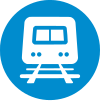
Back Connex Melbourne Spanish Melbournen paikallisjuna Finnish Train de banlieue de Melbourne French Jernbanen i Melbourne NB Railways in Melbourne SIMPLE Melbournes pendeltåg Swedish Мельбурнська міська електричка Ukrainian 墨尔本城市铁路 WUU 墨爾本城市鐵路 Chinese 墨爾本城市鐵路 ZH-YUE
| Melbourne rail network |
|---|
 |
| Metropolitan lines |
|
Alamein Belgrave Glen Waverley Lilydale Craigieburn Sunbury Upfield Flemington Racecourse Frankston Werribee Williamstown Sandringham |
| Non-electrified metropolitan lines |
| Stony Point Deer Park–West Werribee |
| Under construction |
| Metro Tunnel Suburban Rail Loop Melbourne Airport Level Crossing Removal Project |
| Other |
| City Loop • List of stations • List of closed stations • Freight railways • Proposed extensions |
The Melbourne rail network is a metropolitan suburban and freight rail system serving the city of Melbourne, Victoria, Australia. The metropolitan rail network is centred around the Melbourne central business district (CBD) and consists of 222 railway stations across 16 lines, which served a patronage of 99.5 million over the year 2021–2022.[1] It is the core of the larger Victorian railway network, with regional links to both intrastate and interstate rail systems.
Metro Trains Melbourne operates the Melbourne metropolitan rail network under franchise from the Victorian Government, overseen by Public Transport Victoria, a division of the Department of Transport and Planning. The government-owned entity V/Line operates trains from Melbourne across regional Victoria.[3] The first steam train in Australia commenced service in Melbourne in 1854 between Flinders Street and Sandridge, with the metropolitan rail network having grown over the last two centuries to cover much of the city and greater Melbourne area.
The metropolitan network is a suburban rail system designed to transport passengers from Melbourne's suburbs into the Melbourne central business district (CBD) and associated city loop stations, with the main hub at Flinders Street station. Southern Cross station is the main interchange station between metropolitan and regional V/Line services. A new underground line is currently under construction as part of the Metro Tunnel project, which aims to increase network capacity and provide Melbourne with a turn-up-and-go metro-like service.[4] A major new orbital line is also under construction and would be the network's first autonomous line.
A total length of 998 km of track is owned by VicTrack and leased to train operators through Public Transport Victoria.[5] The railway network is primarily at ground level, with some underground and elevated sections.[6] There were more than 170 level crossings before the Level Crossing Removal Project commenced in 2015 to grade separate 110 of the busiest crossings and rebuild 51 railway stations, with 67 crossings removed by December 2022.[7] The metropolitan network operates primarily between 5:00 a.m. and midnight, with overnight services on Friday night to Saturday morning and Saturday night to Sunday morning, departing from Flinders Street only.[8] Some tracks are also used by freight trains and V/Line regional services.
In addition to the primary commuter and freight railway networks, Melbourne also features heritage railways such as Puffing Billy and has the world's largest urban tram network.
- ^ a b c "Department of Transport Victoria Annual Report 2021-2022". static.ptv.vic.gov.au. September 2022. Archived from the original on 24 December 2022. Retrieved 25 December 2022.
- ^ a b Bureau of Infrastructure and Transport Research Economics (BITRE), Australian Government Department of Infrastructure, Transport, Regional Development and Communications (December 2021). "Australian Infrastructure and Transport Statistics, Yearbook 2021" (PDF). Archived (PDF) from the original on 23 February 2023. Retrieved 6 February 2023.
{{cite web}}: CS1 maint: multiple names: authors list (link) - ^ "Public transport partnership agreements". www.ptv.vic.gov.au. Archived from the original on 28 April 2018. Retrieved 28 April 2018.
- ^ "Melbourne on Track For Tokyo's Turn Up And Go Network". Premier of Victoria. 26 September 2016. Archived from the original on 28 April 2018. Retrieved 28 April 2018.
- ^ "Who We Are". www.metrotrains.com.au. Archived from the original on 15 January 2021. Retrieved 27 December 2020.
- ^ "Cross out Melbourne's level crossings – Public Transport Users Association (Victoria, Australia)". www.ptua.org.au. 2 September 2009. Archived from the original on 28 April 2018. Retrieved 28 April 2018.
- ^ "About | Level Crossing Removal Authority". levelcrossings.vic.gov.au. Archived from the original on 28 April 2018. Retrieved 28 April 2018.
- ^ "All Night Public Transport on Weekends Here To Stay". Premier of Victoria. 22 April 2017. Archived from the original on 29 April 2018. Retrieved 28 April 2018.
© MMXXIII Rich X Search. We shall prevail. All rights reserved. Rich X Search

